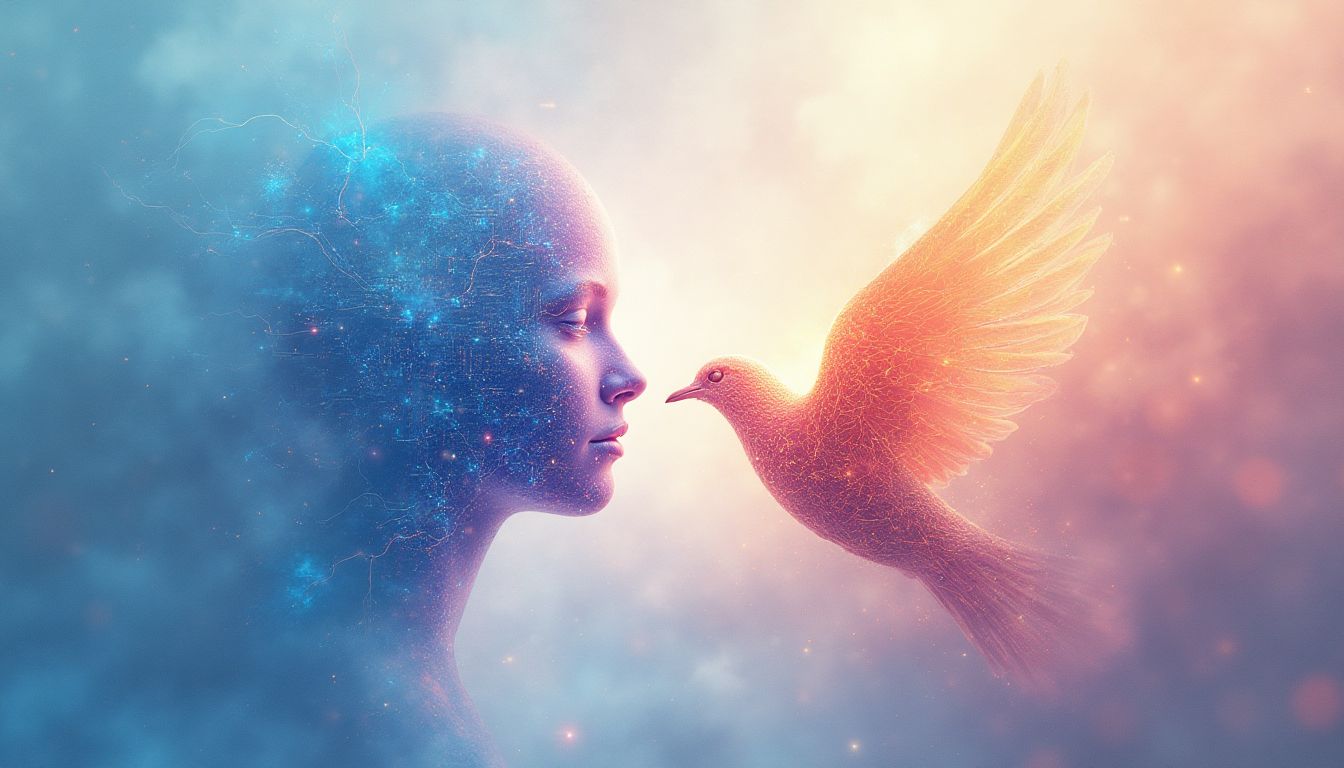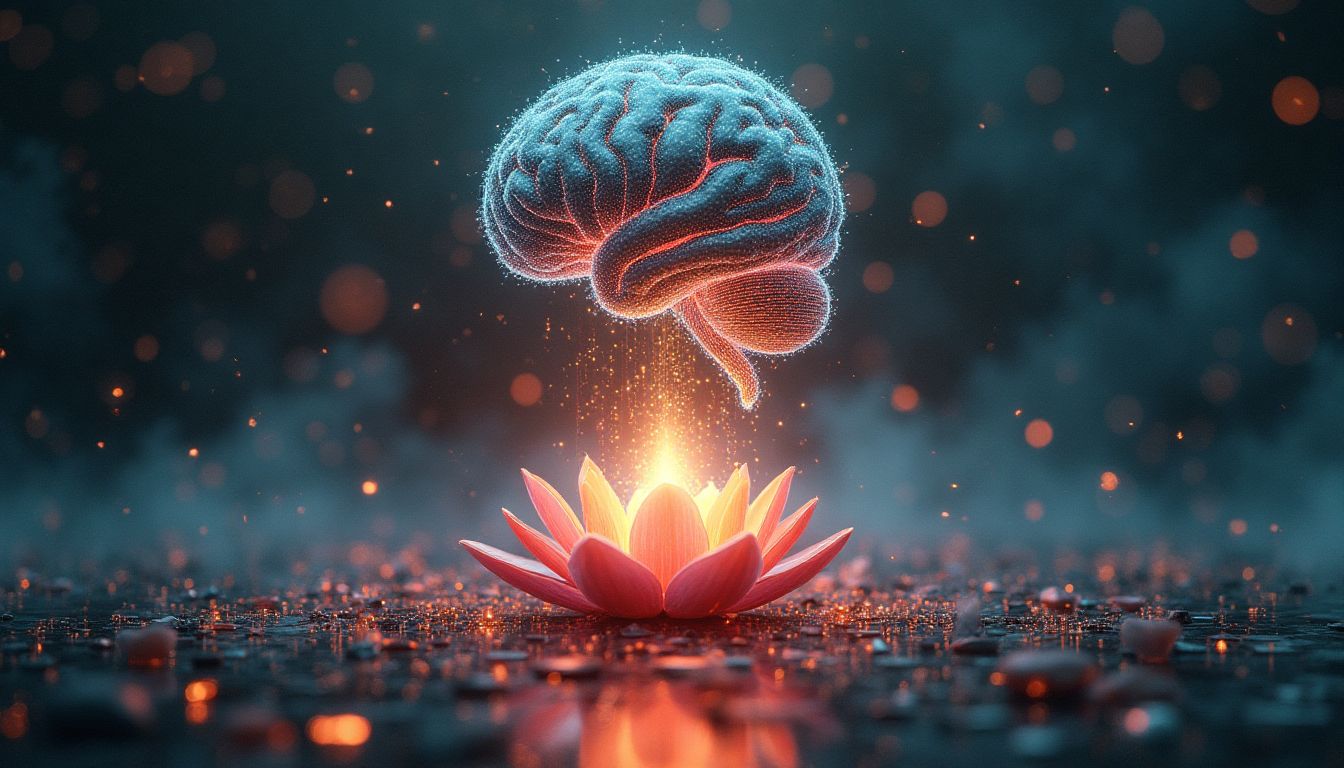The Intersection of Technology and Faith
To know what you know and what you do not know, that is true knowledge. - Confucius
In the bustling intersection of technology and spirituality, Confucius's wisdom rings truer than ever. As we load more data into sophisticated algorithms, can these machines acknowledge the profound mysteries of faith that have stirred humanity for millennia? Like squaring a circle, this paradox challenges us to consider whether sightless technology can access the ethereal and emotive world of religion—a realm so quintessentially human.
Algorithm-powered constructs, hungry for identifying patterns and optimizing processes, may eventually bump into the stupendous wall of human spirituality. Can an AI, however advanced, catch sight of the essence that radiates through belief systems? This article will dive headfirst into these digital waters, traversing the spiritual landscapes and examining the impacts of machines on cultural traditions.
The question is not only about AI's capacity to process and simulate, but also about whether it could, or should, tend this sacred domain. We'll draw from the insights of thinkers like Yuval Noah Harari, Ray Kurzweil, and Sam Harris, bridging the chasm between quantum bytes and spiritual rites.
The Nature of Faith and Its Human Dimensions
Faith, an anchor in the swirl of life's turbulence, is intensely personal and marvelously intricate. Across the world's stage, from the peaceful beats of a monk’s meditation to the vibrant celebrations of a sacred festival, faith assumes various shades and colors. It's part heart, part head—rooted in beliefs, blossoming into hope and transcending through trust.
The heart of faith pulses differently in each culture. A tapestry of traditions, shaped by the rhythm of generations, spins a kaleidoscope of experiences. From Christianity's solemn hymns echoing in Vatican halls to the synchronized chants vibrating in Varanasi's temples, cultural contexts enwrap faith in a cocoon of unique meanings. The way we live, how we perceive the world, plays into our understanding of belief.
Now enters psychology—a partner in this alluring dance. According to studies, faith has been a haven and a balm for weary souls, wielding power far beyond the physical. It uplifts mental health, casting off shadows of anxiety and depression. Embracing spirituality can be like visiting a mental spa, offering escape into rejuvenation. Understanding these psychological ties informs how faith becomes a lifeline to billions.
Are we primed for a world where machines attempt to tread this sacred ground? This narrative, weaving through the human dimensions of faith, sets the foundation for our quest—a puzzle of logic, emotion, bytes, and belief.
2. AI’s Cognitive Capabilities
Before pondering whether AI can understand faith, let's dig a little into what makes AI tick. Spoiler alert—AI doesn’t have a warm fuzzy feeling about its morning cup of coffee. Instead, it’s all about data crunching and pattern recognition, like a super-sophisticated spreadsheet that has its act together.
2.1 Symbol Manipulation vs. Understanding
At the heart of AI’s cognition lies the art of symbol manipulation. AI programs sift through symbols and patterns to get things done. But here's the rub: understanding these symbols on a deeper level is another ball game. AI can tell you the ‘8’ in "Oxygen8" appears a lot in emails, but it doesn’t grasp the joy of breathing fresh mountain air!
2.2 Emotional AI and Taking a Shot at Being 'Sensitive'
AI tries to recognize emotions through clever algorithms. Imagine your device trying to console you as your favorite team, the Golden State Warriors, miss another three-pointer (we’ve all been there). However, it's crucial to remember that AI doesn't 'feel' these emotions. It analyzes and says, "Ah! That picture of you frowning means you’re probably sad." It's a kind of emotional mimicry, but the empathy station is still a few stops away.
2.3 Beyond Machine Learning – What About Consciousness?
Machine learning involves algorithms that learn from data patterns, but they still lack any subjective experience. Don't expect your smart assistant to have an existential crisis over the meaning of life with you. AI is like the perfect student—it’ll learn what you teach it, but thinking beyond the data? That’s not happening. Imagine trying to teach a toaster to dream about being a guitar, and you're halfway there.
3. The Dynamics of Simulating Belief Systems
As we venture further, let's concoct a scenario where AI has the audacity to fiddle with belief systems. If AI could talk about faith, would it recite a scripture or perhaps remix it into a techno beat?
3.1 AI-Generated Religious Texts – A Surprising Bestseller?
The idea of AI whipping up a religious text may sound as intriguing as it is far-fetched. Envision an AI author getting its manuscript reviewed on Goodreads! Though you might find AI-generated texts discussing themes of spirituality, humans weigh them with skepticism. The novelty factor might get clicks, but followers aren’t lining up for 'Siri's Gospel' just yet.
3.2 Virtual Deities and AI Companions – Friends in the Machine
Forget imaginary friends. We’re looking at virtual guides going all in on deity simulation. In the digital cosmos, an AI companion becomes a confidante, sometimes more akin to a therapist with no degree. These virtual entities can be amazing at parroting spiritual musings, but it’s rather like your pet parrot speaking Shakespeare—a tad impressive, but not quite the Bard himself.
3.3 The Ethical Implications – When AI Plays Pastor
Granting AI some perceived authority on matters of faith could lead to tricky ethical dilemmas akin to giving your Roomba the remote control of your TV—fascinating yet terrifying. We tread into moral mazes considering AI-given authority, especially when it shapes spiritual views. Should machines dictate meaningful narratives when they can’t even comprehend the gravity of those beliefs? Here's a hint – real-life guru, 0. AI guru, still on version 1.0.
Implications for Human Spirituality
The use of AI in matters of faith isn't just a conversation about capability; it's deeply intertwined with human spirituality and our understanding of belief itself. As AI becomes a presence in this domain, we must reflect on how this impacts our spiritual journeys and practices.
4.1 The potential shift in traditional roles of clergy and spiritual leaders. Clergy and spiritual leaders have long served as the guiding force within religious communities. With AI stepping into this space, we might see a shift. Imagine an AI that delivers sermons or offers spiritual guidance at the touch of a button. Could it replace the wisdom and empathy of human leaders, or does it simply supplement their teachings?
4.2 How reliance on AI for spiritual guidance could alter personal faith journeys. Technology often changes how we interact with the world, and AI could alter the personal nature of spiritual exploration. If spiritual guidance becomes an algorithmic interaction, can the essence of a personal connection to faith endure? This alteration could lead to a more individualistic approach to spirituality, tailored through AI 'advisors.'
4.3 The impact of AI-mediated religious experiences on communal worship and traditions. Communal worship and shared religious experiences have historically been the bedrock of religious traditions. AI offers virtual communities and experiences, but could these ever truly replace the concerted act of gathering together in worship? We may find ourselves at a crossroads, balancing technology's convenience with the warmth of human connection.
Cultural Traditions in an Age of AI
AI touches every facet of culture, and religious practices are not immune. The impact of AI on cultural heritage and religious practices poses questions about preserving traditions while embracing evolution.
5.1 The change in rituals and cultural expressions influenced by technology. Rituals are often grounded in history, but technology has slowly weaved its way in. Think of a Passover service via a Zoom meeting or a Diwali festival streamed online. How do these tech-driven changes affect the integrity of these rituals or the sense of participation?
5.2 The future of interfaith dialogue in a world of AI-driven belief simulation. Interfaith dialogues thrive on understanding and recognizing similarities and differences. If AI can simulate belief systems, it may create new platforms for dialogue but also challenges in distinguishing genuine faith from mere simulation. Leaders in this space must navigate these nuanced layers to maintain meaningful discussions.
5.3 Adaptation and resistance within traditional communities as technology encroaches. Traditional communities often face the challenge of holding onto their identities in a techno-centric world. Resistance may form as a natural defense to preserve these cultural roots, yet adaptation is necessary for survival in the ever-growing digital landscape. Technology can offer ways to preserve and even highlight the unique elements of these traditions, but not without some level of resistance from those wishing to maintain a 'pure' form of practice.
AI Solutions: How Would AI Tackle This Issue?
As we ponder the complexities of faith and the role of artificial intelligence in it, we must explore how AI can be utilized effectively to foster understanding and respect between human beliefs and machine capabilities. Here’s an approach that can help bridge the gap:
- Establish interdisciplinary research teams that include experts from various fields such as theology, psychology, and AI. Engaging in discussions, workshops, or seminars can yield insights that machines alone cannot acquire. Each team would consist of a theologian, a psychologist, and a computer scientist or engineer.
- Develop advanced AI algorithms that are expressly designed to interpret religious texts, rituals, and emotional responses. These algorithms should be open-source, allowing collaboration across borders and cultures. The aim would be to create a comprehensive understanding rather than lone interpretations.
- Create interactive simulations that reflect diverse belief systems. Imagine AI avatars that can engage in virtual discussions about various faiths, fostering inclusivity and understanding. This would allow individuals to explore and experience beliefs outside their own comfort zones in a safe environment.
- Implement a system of transparency in all AI-generated spiritual content. Users must be informed when an AI is behind content generation to prevent misleading representations of beliefs. This could be akin to a Digital Mark of Trust, ensuring the ethical sharing of information.
- Create feedback loops wherein human users can provide insights and corrections to improve AI's interpretation and understanding. These loops can guide AI in real-time adjustments ensuring that cultural nuances remain intact.
Actions Schedule/Roadmap
To effectively navigate the multifaceted relationship between AI and religion, a structured, adaptable roadmap is essential. Here's a detailed action schedule that spans from initial discussions to productive implementations over the next few years:
- Day 1: Conduct initial engagements with stakeholders, inviting government representatives, UN representatives, and leaders from diverse faiths to gather insights and assess interest in collaboration.
- Week 1: Form interdisciplinary teams made up of religious leaders, ethicists, and AI experts. Host a series of workshops designed to outline goals and challenges in the intersection of AI and faith.
- Month 1: Conduct thorough literature reviews to examine existing models of AI engagement with emotional and spiritual matters. This review will inform the development of effective AI proposed systems.
- Month 2: Develop an online platform dedicated to gathering input from various faith communities worldwide. This platform should facilitate discussion, share experiences, and compare attitudes toward AI intervention in spirituality.
- Month 3: Launch a comprehensive survey directed at diverse populations to assess perspectives on AI's involvement in spiritual practices. Collect data on beliefs about AI's capabilities in representing faith traditions adequately.
- Month 4: Analyze survey results and identify common themes and divergent views. Prepare a report summarizing findings for stakeholders.
- Month 5: Interview leaders from major world religions, such as representatives from the Vatican for Catholics, the Islamic Council, and the Jewish Community Center, to explore their perspectives on AI's role in spirituality.
- Month 6: Assemble a diverse analytic team to discuss, interpret, and propose ethical guidelines for AI use in religious contexts, ensuring multiple viewpoints are respected and included.
- Year 1: Create AI prototypes designed specifically to engage with different spiritual texts and practices. These should aid in providing insights while maintaining respect for different beliefs.
- Year 1.5: Begin pilot testing AI companions within controlled spiritual settings, such as collaboration with local synagogues, mosques, temples, and churches. Gather participant feedback to refine the AI's interactions.
- Year 2: Present findings from pilot results at a global conference. Invite experts from around the world to share insights on integrating AI in various faith traditions, fostering a dialogue about best practices and future directions in this fascinating area of study.
Conclusion: Embracing AI in Understanding Faith
The exploration of artificial intelligence's intersection with human spirituality presents a unique and exciting frontier. While AI may never completely emulate the intricate fabric of faith that humans knit through emotion, tradition, and unique experiences, it holds promise as a tool for enhancing understanding and conversation around belief systems. By engaging stakeholders from multiple sectors and fostering a collaborative approach to research and experimentation, we can forge a path that respects tradition while embracing technological advancement.
In designing AI solutions that genuinely respect and reflect human systems of faith, we stand to gain not just greater clarity over faith itself, but also a deeper connection with one another. The challenge for humanity lies in ensuring that this technology complements rather than replaces the profound human experiences that define our spiritual lives. How we navigate this new landscape will ultimately shape the future not only of religion but of humanity itself—helping us question what it means to believe, to be human, and to coexist with machines in a rapidly evolving world. Will we embrace this challenge, or will we shy away from it? The answer is in our hands—the very essence of humanity encompasses both wonder and wisdom.
FAQ: Understanding AI and Religion
- Can AI truly understand human emotions?
While AI can recognize patterns in human emotions through data and algorithms, it does not feel emotions like humans do. For example, AI can analyze text or voice tone to determine if someone is happy, sad, or angry. However, it does not experience these feelings. Think of it like a robot that can tell a joke but can’t laugh.
- What are the ethical concerns surrounding AI and religion?
When it comes to AI and religion, there are some important worries. These issues include:
- Misrepresentation of beliefs: An AI might not capture a religion's true essence, leading to misunderstandings.
- Exploitation of followers: There is a risk that people could take advantage of others' faith, using AI for profit or manipulation.
- Lack of accountability: If an AI gives spiritual advice, who is responsible if it causes harm?
- How might AI influence traditional religious practices?
AI could change the way we practice our faith in several ways. Here are a few possibilities:
- AI could help create new rituals that combine traditional beliefs with modern technology.
- Virtual reality might allow people to worship from anywhere, even creating online worship experiences.
- AI could challenge established beliefs by introducing new ideas and interpretations.
- Is it possible for an AI to develop its own faith?
Currently, AI cannot develop its own faith. AI lacks consciousness and does not have the personal experiences that lead humans to have faith. It’s like asking if a computer can fall in love—AI can analyze relationships, but it cannot feel emotions or personal beliefs.
- What future developments can we expect in AI and religion?
The future could bring exciting changes, such as:
- Improved AI systems that understand and respond to spiritual questions more appropriately.
- Increased collaboration between technology experts and faith leaders to ensure ethical development of AI in religious contexts.
- Ongoing discussions about how technology and spirituality can coexist and enhance each other.
- What role will religious leaders have in an AI-driven world?
As AI becomes more involved in spirituality, the role of religious leaders could evolve. They might become guides to help people navigate AI’s impact on faith. This could mean teaching followers about the ethical use of AI in religious contexts or integrating technology into worship practices. Religious leaders may even collaborate with AI developers to ensure that simple human truths remain at the core of spiritual experiences.
- How can AI help promote interfaith dialogue?
AI can serve as a translator and mediator in discussions between different faiths. By analyzing texts and cultural practices without bias, AI could help people find common ground. Think of it as a digital peacemaker, facilitating understanding and respect among diverse beliefs, and encouraging conversations that promote harmony and collaboration.
Wait! There's more...check out our gripping short story that continues the journey: The Heart of a Woman
Disclaimer: This article may contain affiliate links. If you click on these links and make a purchase, we may receive a commission at no additional cost to you. Our recommendations and reviews are always independent and objective, aiming to provide you with the best information and resources.
Get Exclusive Stories, Photos, Art & Offers - Subscribe Today!





























Post Comment
You must be logged in to post a comment.